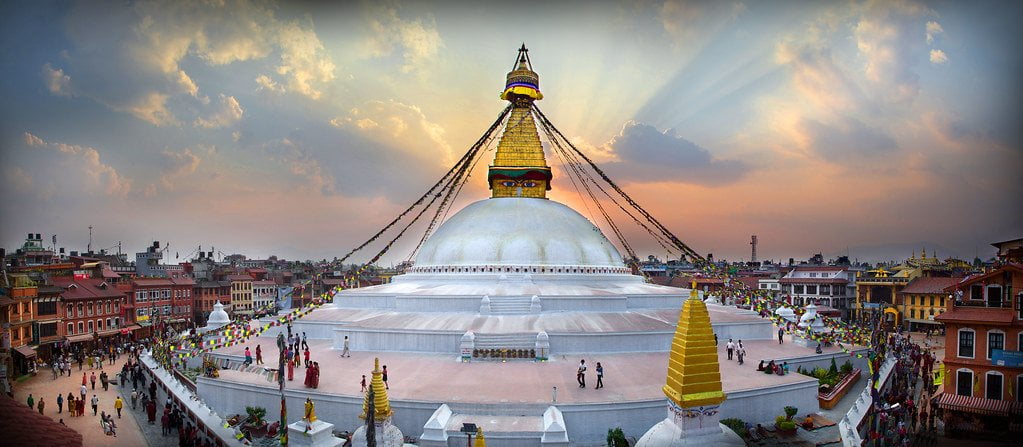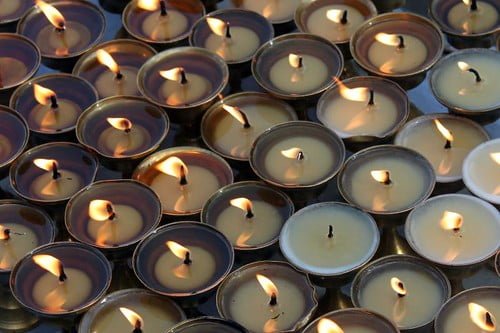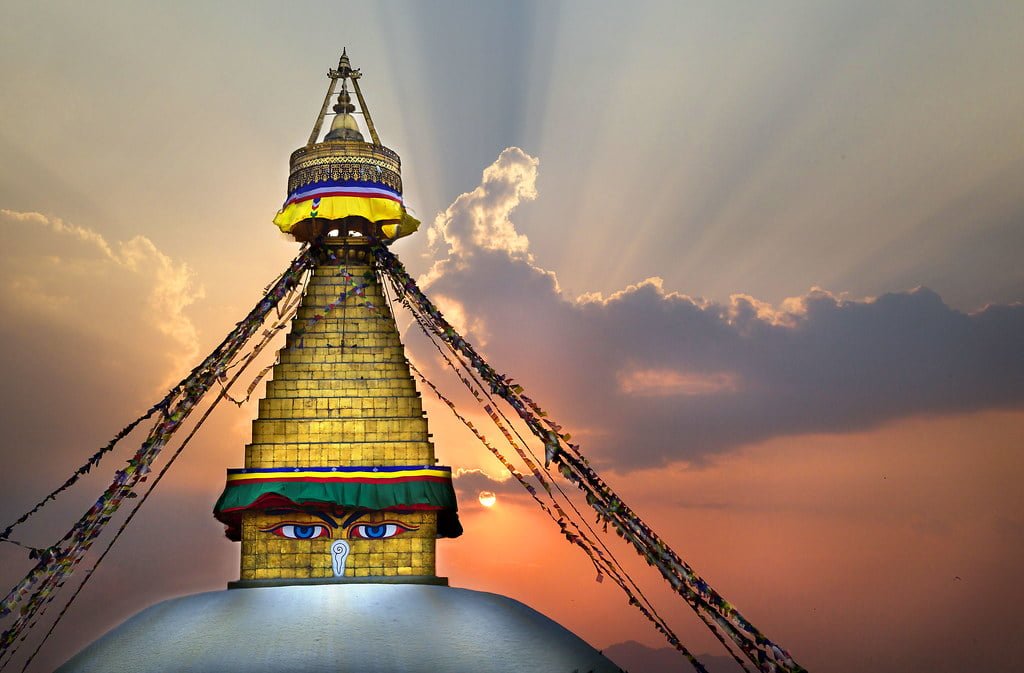Boudhanath Stupa
Boudhanath Stupa is a significant religious site that holds great importance in the Buddhist faith. Buddhism is the religion associated with Boudhanath Stupa, and it is considered one of the holiest Buddhist sites in Nepal. The stupa serves as a place of worship, meditation, and pilgrimage for Buddhists from around the world.
The Boudhanath Stupa is a symbol of the Buddhist path to enlightenment. It is believed to enshrine relics and remains of the Buddha, including those of Kashyapa Buddha, one of the previous Buddhas. These sacred relics and the spiritual energy of the stupa are believed to bring blessings, protection, and answers to prayers.
The history of Boudhanath Stupa dates back to the 14th century when it was initially constructed. However, the origins of the stupa can be traced even further to the time of the Tibetan king, Songtsen Gampo, who converted to Buddhism in the 7th century.
The first stupa at Boudhanath was built sometime after AD 600 under the patronage of King Songtsen Gampo. Over the centuries, the stupa underwent several renovations and restorations, with significant contributions from various individuals and communities.
One notable mention in the history of Boudhanath Stupa is the contribution of Jogchen Shyabkar Chokdrul Rangdol in 1818-19 A.D. He kept gold-plated copper in the Harmika of the stupa, adding to its grandeur. After his passing, his sons continued the remaining work on the stupa, ensuring its preservation.
In 1859 A.D., the Chiniya Lama tradition became an integral part of the history of Boudhanath Stupa. Chiniya Tai Fo Sing was appointed as the priest of the stupa by the prime minister Rana. This tradition played a significant role in the preservation and worship of the stupa.
The local Tamang community has also played a vital role in the worship and preservation of Boudhanath Stupa. They have upheld the religious significance of the stupa and actively participated in its maintenance.
In 1979, Boudhanath Stupa was recognized as a UNESCO World Heritage Site, further cementing its historical and cultural importance. Today, it stands as one of the largest and most important Buddhist stupas in Nepal, drawing both Nepalese and Tibetan Buddhists for worship and pilgrimage.
From its construction in the 14th century to its various renovations and restorations over the centuries, the history of Boudhanath Stupa is a testament to its enduring spiritual significance and architectural beauty. It continues to be a revered site, attracting visitors from all over the world who seek enlightenment and inspiration in its sacred atmosphere.
Cultural and Spiritual Significance
Boudhanath Stupa holds immense cultural and spiritual significance, attracting visitors from all over the world. This ancient sacred site is not only a symbol of Nepal’s rich heritage but also a beacon of tranquility and spiritual energy.
The stupa serves as a center for various spiritual practices and teachings. Tibetan Buddhist schools, monasteries, and nunneries surround the stupa, making it a hub for monks, nuns, and spiritual seekers. Visitors have the opportunity to participate in meditation sessions and engage in Buddhist teachings, allowing them to immerse themselves in the Buddhist way of life and gain a deeper understanding of its principles.
Boudhanath Stupa is not just a pilgrimage destination; it is also a hub for cultural festivals. Throughout the year, various festivals are celebrated here, showcasing the vibrant traditions and rituals of the Nepali and Tibetan communities. Visitors have the opportunity to witness these cultural festivities and immerse themselves in the vibrant atmosphere of Boudhanath.
Inspiring artists and writers have also found solace and inspiration in the serene environment of Boudhanath Stupa. The peaceful ambiance, the hum of prayers, and the colorful prayer flags fluttering in the wind provide the perfect backdrop for creative endeavors. Many artists and writers have been drawn to this sacred site, creating artworks and literature that capture the essence of Boudhanath’s spiritual energy.

UNESCO World Heritage Site Status
Recognized by UNESCO as a World Heritage Site in 1979, Boudhanath Stupa holds global significance. Its cultural and architectural marvels have been acknowledged universally, solidifying its status as a cultural landmark. The stupa is not only admired for its physical beauty but also for its resilience and hope. After the devastating earthquake in 2015, the restoration efforts brought together local and international communities, showcasing the global recognition and support for this sacred site.
Daily Rituals and Practices
The significance of prayers, prayer flags, and prayer wheels
Prayers, prayer flags, and prayer wheels hold immense significance in the context of the Boudhanath Stupa in Kathmandu, Nepal. These sacred practices are deeply rooted in Buddhist tradition and play a vital role in spiritual devotion and seeking enlightenment.
Prayers are a fundamental aspect of Buddhism, serving as a means to communicate with the divine and express gratitude. At the Boudhanath Stupa, prayer flags and prayer wheels are used as tools to enhance the power of prayers and spread blessings to the heavens.
Prayer flags, which can be seen fluttering in the breeze around the stupa, are believed to carry prayers and intentions to the divine realms. These colorful flags are inscribed with sacred texts and mantras, and as they sway in the wind, the prayers are believed to be released and carried to the heavens. The act of hanging prayer flags is considered a meritorious deed, as it is believed to accumulate positive energy and bring good fortune.
Similarly, prayer wheels are another powerful tool for accumulating merit and spreading blessings. Surrounding the base of the Boudhanath Stupa, devotees can find prayer wheels which they spin while chanting prayers or mantras. The spinning of the prayer wheel is considered equivalent to reciting the prayers multiple times, thus multiplying the spiritual benefits. This practice is believed to purify negative karma, bring about peace and harmony, and ultimately lead to enlightenment.
Both prayer flags and prayer wheels serve as tangible reminders of the importance of mindfulness and the continuous practice of devotion. They serve as visual cues to practitioners to keep their thoughts and intentions focused on spiritual growth and liberation from worldly desires.

Ritual placement and the clockwise direction of circumambulation
One of the key aspects of the Boudhanath Stupa is the ritual placement and the significance of circumambulating the stupa in a clockwise direction. As visitors enter the stupa, they are immediately greeted by the sight of the massive dome and the people walking in a circular path around it. This practice is known as circumambulation or pradakshina in Buddhist tradition, and it holds deep symbolic meaning.
The clockwise direction of circumambulation is considered the correct practice at the Boudhanath Stupa. It is believed that by walking in this direction, individuals align themselves with the natural force and tap into the positive energy that surrounds the stupa. Going in the anti-clockwise direction is considered a wrong practice, as it goes against the flow of this natural energy.
The significance of the clockwise direction can be traced back to ancient Buddhist beliefs. It is believed that walking in this direction helps to purify one’s mind, body, and soul. It is also seen as a way to honor the teachings of Lord Buddha and to express devotion and respect towards the stupa as a sacred symbol.
Architectural Features
The unique design of the stupa and its symbolism
The Boudhanath Stupa, with its distinctive design and rich symbolism, stands as a remarkable testament to the Buddhist faith and its teachings. The stupa’s architectural elements and intricate details hold deep meaning and significance for both Nepalese and Tibetan Buddhists.
At a height of approximately 36 meters (118 feet), the main structure of the Boudhanath Stupa is an imposing sight. It is crowned with a gilded pinnacle, adorned with the Buddha’s eyes. These eyes symbolize wisdom and compassion, serving as a constant reminder of the core values of Buddhism.
The base of the stupa is adorned with 108 small images of the Dhyani Buddha Amitabha. The number 108 holds great importance in Buddhist tradition, representing the various defilements or negative emotions that one must overcome to achieve enlightenment. Each of these small images serves as a reminder of the path towards spiritual awakening and liberation.
Colorful prayer flags, decorated with mantras and prayers, adorn the Boudhanath Stupa. These vibrant flags flutter in the wind, spreading blessings and positive energy to all those who witness them. The flags also symbolize the impermanence of life, reminding visitors of the Buddhist concept of transience and the need to cultivate mindfulness in all actions.
The octagonal base upon which the stupa is built represents the Noble Eightfold Path of Buddhism. This path, consisting of right view, right intention, right speech, right action, right livelihood, right effort, right mindfulness, and right concentration, is the fundamental guide to achieving enlightenment. The octagonal shape of the base serves as a constant reminder of the importance of following this path in one’s daily life.
Beyond its architectural design, the Boudhanath Stupa holds immense cultural and spiritual significance. It is an important center for Tibetan Buddhism and Tibetan refugees in Nepal. Tibetan Buddhists consider the stupa a sacred site, making it a popular pilgrimage destination for devotees from around the world.
During Buddhist festivals like Losar and Buddha Jayanti, the stupa becomes particularly vibrant, with devotees engaging in various religious rituals and prayers. It is believed that by spinning the prayer wheels around the stupa, one can accumulate merit and blessings. These festivals provide an opportunity for visitors to immerse themselves in the rich tapestry of Buddhist traditions and deepen their understanding of the Buddhist way of life.

Boudhanath Stupa Today
Can you go inside the Boudhanath Stupa?
Unfortunately, entering the Boudhanath Stupa itself is not allowed for visitors. The stupa is considered a sacred site and a place of worship for Buddhists, so it is primarily reserved for religious activities and ceremonies. However, this should not deter you from visiting the stupa. The Boudhanath Stupa complex has much to offer in terms of exploration and observation from the outside. The Stupa is surrounded by a vibrant and bustling neighborhood, with numerous monasteries, temples, shops, and restaurants.
You can take a leisurely stroll around the stupa’s perimeter, known as the kora, which is a traditional Buddhist practice of circumambulation. Walking clockwise around the stupa while spinning prayer wheels is believed to accumulate merit and bring blessings. This practice is followed by both locals and visitors alike.
What is the myth of the Boudhanath Stupa?
One of the most prominent myths surrounding the Boudhanath Stupa is its origin story. According to legend, the stupa was built by a devout and wealthy merchant named Sindhu. He had a dream in which he saw the exact location where the stupa should be constructed. Inspired by this divine message, Sindhu set out on a mission to build a grand stupa that would become a symbol of enlightenment and a beacon of hope for all beings.
As the construction of the stupa began, a series of miraculous events occurred. It is said that even though the workers toiled all day to build the structure, it would mysteriously collapse during the night. This continued for several nights, leaving the workers perplexed and disheartened. However, Sindhu remained steadfast in his faith and sought the guidance of a wise Buddhist sage.

